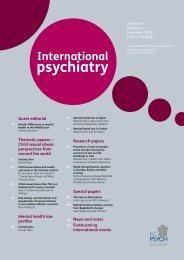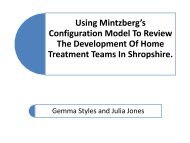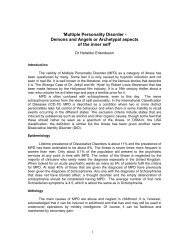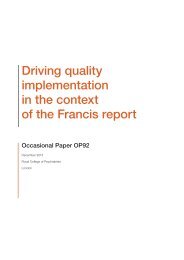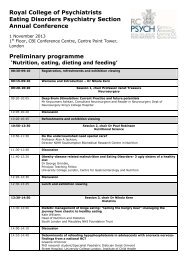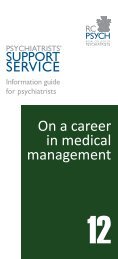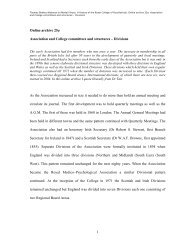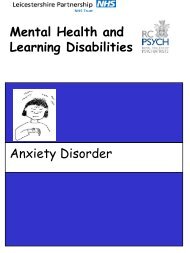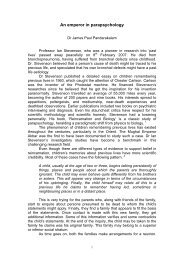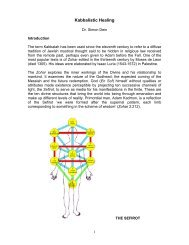A Search for the Truth of Near Death Experiences
A Search for the Truth of Near Death Experiences
A Search for the Truth of Near Death Experiences
You also want an ePaper? Increase the reach of your titles
YUMPU automatically turns print PDFs into web optimized ePapers that Google loves.
underlying NDEs have been speculated upon, <strong>the</strong>re is no research demonstrating <strong>the</strong> actual<br />
physiological conditions associated with NDEs. 14,15,16<br />
According to <strong>the</strong> biochemical view hallucinatory neurotransmitters and endorphins are<br />
thought to be responsible <strong>for</strong> NDEs. 17,18 So far, no NDE specific transmitter constellations<br />
have been detected. Stress-induced limbic lobe dysfunction is a neurological explanation. 14<br />
Ano<strong>the</strong>r neurological view is that <strong>the</strong> ‘NDE is similar to <strong>the</strong> autoscopic hallucination. 19 In <strong>the</strong><br />
OBE, <strong>the</strong> centre <strong>of</strong> thinking is in <strong>the</strong> ‘second body’ and in <strong>the</strong> case <strong>of</strong> autoscopic<br />
hallucination <strong>the</strong> centre <strong>of</strong> thinking is still in <strong>the</strong> physical body. Electrical stimulation <strong>of</strong> <strong>the</strong><br />
temporal lobe has produced NDE-like experiences. However, visual hallucinations in this<br />
situation as well as in temporal lobe epilepsy are mere visual disturbances and not intact<br />
visual images as in NDE perceptions. The NDE has also been hypo<strong>the</strong>sised to be a<br />
protective mechanism to conserve energy and provide necessary brain stimuli. 20<br />
Hart (1954) identified 288 published cases in which a person claimed to have perceived<br />
events at some distant location while in <strong>the</strong> extra-somatic state. 21 It is also worth mentioning<br />
that OBE have been reported to occur in healthy individuals and under experimental<br />
conditions. 22,23,24,25 Depersonalisation syndrome occurring at <strong>the</strong> time <strong>of</strong> life threatening<br />
danger was ano<strong>the</strong>r speculation. 26 Psychologists have postulated that NDEs are <strong>the</strong> product<br />
<strong>of</strong> mental defence mechanisms – denial, dissociation, wish fulfilment, regression and<br />
projection. Yet in <strong>the</strong> NDE, <strong>the</strong> subject is not escaping from <strong>the</strong> situation; he is frequently<br />
witnessing <strong>the</strong> scene <strong>of</strong> resuscitation. NDEs have common elements and are independent <strong>of</strong><br />
<strong>the</strong> belief system. Even when patients are sure to recover, <strong>the</strong>y may still experience an NDE.<br />
The replay <strong>of</strong> birth experience has been a popular psychological explanation. 27 Regression<br />
is used to explain <strong>the</strong> mystical elements (regression to a state be<strong>for</strong>e ego differentiation). But<br />
again, <strong>the</strong> NDE is experienced with an integrated ego identity.<br />
The tunnel experience is compared to <strong>the</strong> birth canal experience. New-born children have<br />
very poor perception <strong>of</strong> objects. But NDEers have full perception <strong>of</strong> objects. Nei<strong>the</strong>r is <strong>the</strong><br />
birth experience a ‘positive’ one. People who had Caesarean births also have had NDEs.<br />
Tunnel experiences are reported to occur with hallucinogenic drugs, hypnogogic and ecstatic<br />
states, argued to be <strong>the</strong> result <strong>of</strong> over activity <strong>of</strong> <strong>the</strong> visual cortex and not announcing<br />
proximity <strong>of</strong> death. The collective unconscious and <strong>the</strong> archetypes are used to explain NDE.<br />
However, OBEs cannot be explained according to Jungian <strong>the</strong>ories. Finally, NDEs have<br />
been compared to o<strong>the</strong>r mental reactions to perceived threat, coloured by culture and<br />
current stress. 28<br />
None <strong>of</strong> <strong>the</strong> organic and psychological <strong>the</strong>ories explain <strong>the</strong> externally verifiable in<strong>for</strong>mation<br />
<strong>the</strong> subjects give after <strong>the</strong> bodily separation. How can some persons who are ostensibly<br />
unconscious, if not dead, never<strong>the</strong>less perceive <strong>the</strong>ir bodies from above, and sometimes<br />
become aware <strong>of</strong> events occurring outside <strong>the</strong> reach <strong>of</strong> <strong>the</strong>ir ordinary senses? The biological<br />
interpretations do not adequately explain <strong>the</strong> enhanced cognitive abilities <strong>of</strong> <strong>the</strong> NDErs. 29<br />
Parapsychologists believe that enhanced cognitive abilities when <strong>the</strong> brain is underactive<br />
point towards a true involvement <strong>of</strong> extra sensory perception (telepathy, clairvoyance,<br />
precognition). Philosophically oriented investigators think that NDE points towards an<br />
intrinsic spiritual reality. They attach even transcendental importance to <strong>the</strong> reports <strong>of</strong> Light<br />
Beings, making it a symbol <strong>of</strong> modern mysticism outside <strong>the</strong> religious field. 30 Peter Fenwick’s<br />
recent studies have revealed several features <strong>of</strong> NDE that do not con<strong>for</strong>m to <strong>the</strong> usual<br />
4




